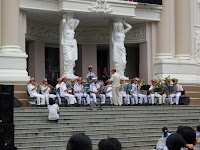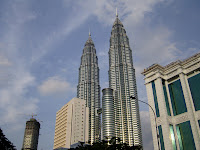
The war is a big part of Saigon's recent history, but the city offers many other fascinating sights and experiences. Instead of heading to the Cu Chi Tunnels, the vast network of underground tunnels constructed and occupied by the Viet Cong just a few kilometres outside the city (where the tours feature a chance to shoot AK-47s for a buck a bullet), I decided to stay in the city and explore. After the museum, I went in search of a little restaurant my guide book listed as the Indian Canteen, tucked back behind the the city's Central Mosque. It took me a couple of times passing the mosque to actually go in - I am still not completely comfortable with entering mosques and temples where I have little knowledge of the protocol. But, I was determined. As you walk all the way around the building, a small alleyway opens into a large eating space, with a dozen tables and several dishes simmering on a large central stove. It was around 5.00 pm, and I was the only one there, but I got a great meal of chicken with curry, rice, vegetables, and Indian bread.
The next day, I planned to get up early and go for a run. Good thing, as I was awakened at around 7 am to the strains of Buddhist chants being amplified throughout the central district. I think some monks had set up their equipment at the Municipal Theatre directly across from my hotel. I went for my run, which may have done more damage than good, given the city's pollution levels, and by the time I returned to the hotel, the music had turned into a full blow military concert. A uniformed band was playing marches for a crowd of onlookers consisting of many cyclo and taxi drivers. In between songs, a young Vietnamese woman would come forward and announce (I guess) the next song. She wore the traditional ao dai (pronounced, "ao zhai"), which is the national dress of Vietnam. It consists of a form-fitting tunic with long panels in the front and back, worn over loose trousers. It is a very graceful ensemble. I include a picture of the spokeswoman here.


After a very Western breakfast in my hotel, in the nicely restored courtyard, I decided to try a cyclo ride. It all starts with a protracted negotiation, usually after a cyclo driver (or several) aggressively approaches you. Once my driver and I had decided on a price, I jumped into the seat, putting my safety in his hands. My driver took me through the crazy traffic of the city - bicycles, motorbikes and scooters, cars, and trucks - to the Jade Emperor Pagoda. Along the way, he pointed out the sights, which included the old U.S. embassy, across the street from the current version, which was the site of the famous scene of the helicopter taking off amid the throng, whisking the last Americans to safety as the war ended. The ride was a bit harrowing, but he knew what he was doing and got me there safely.

The Jade Emperor Pagoda was built by the Cantonese community in 1909, and it is a spectacularly colorful temple filled with statues of "phantasmal divinities and grotesque heroes", as my guidebook states. The monks of the temple were conducting worship when I arrived, with loud chanting and ritualistic burning of joss sticks. I wandered through the hallways to the main sanctuary where the Taoist Jade Emperor (the King of Heaven) presides. He is flanked by the Four Big Diamonds, his guardians, as well as several other Taoist deities, many of them menacing in their appearance and (I suppose) demeanor. On either side of the central altar are two especially fierce figures - the general who defeated the Green Dragon (pictured) and the general who defeated the White Tiger. These statues are more than four metres tall!


Side chambers hold all kinds of other worship areas and statues, but I found one in particular quite interesting. The Hall of Ten Hells features ten carved wooden panels that graphically depict the torments awaiting evil people in the Ten Regions of Hell. At the top of each panel, the Judge of the Region examines a book in which the deeds of the dead are inscribed. Below him are pretty nasty scenes of torture. I won't go into detail, but just know that you don't want to live a bad life. Interestingly, there is a "theme park" in Singapore that has more graphic depictions of the Ten Regions. I just visited the park and will share some of the pictures in another entry.
The temple is like so many others you see in Asia - they seem to spring out of neighborhoods where you would never expect, ornate islands in the middle of retail areas, residences, or even skyscrapers. They offer nice respites from the hustle and bustle of their cities.
On my way back, I had to stop to try a local beer. I had read about Vietnam's tradition of bia hoi (draft beer) or bia tuoi (fresh beer). This is brewed and delivery daily to drinking establishments through the country, and since it does not contain preservatives, it is meant to be enjoyed immediately. Not only soon after its arrival, but also in one gulp - "Tram pha tram!" means 100 percent or bottoms up, and that is the signal to empty the glass. I think this tradition is more prevalent in Hanoi and the north, because I did not see any bia hoi signs. But, I did try some of the local brew. Saigon has two local brands, 333 (ba ba ba) and Saigon Export, and Larue Export is a French holdover from central Vietnam. Each is light and refreshing, a must in the tropical heat. Be careful if you try to order a 333 in local language, however. Depending on how you say it, ba ba ba can mean 333 or 3 old women.
One last visit to Ben Thanh market allowed me to buy my coffee and the single cup filter, which I have used often. It is a bit of a pain to clean, but the coffee is delicious (and keeps me awake for two days). I also had another bowl of pho at Pho 2000 across from the market. Bill Clinton visited there during the last few days of his presidency in 2000, and there are pictures of him with the staff all over the restaurant. I hope he did not choose to put all the chillies in the soup, like I did. At one point, I got lightheaded from the heat and had to stop eating for a minute! What a great way to clear one's head. After that, it was a bit more exploring and a viewing of the Formula One race, which is shown on regular broadcast TV in many places in Asia, not on a premium sports channel.
An early flight on Monday cut short my visit, but I packed in a lot in just under 48 hours. It only stoked my fascination of the country, and I realize that there is much more to see, not only in the south, but north in Hanoi and in parts in between. I hope to visit the country many times while I am over here, and I would recommend to anyone who wants to see a mix of ancient and recent history and experience a wonderful culture and vibrant people, visit Vietnam.



























